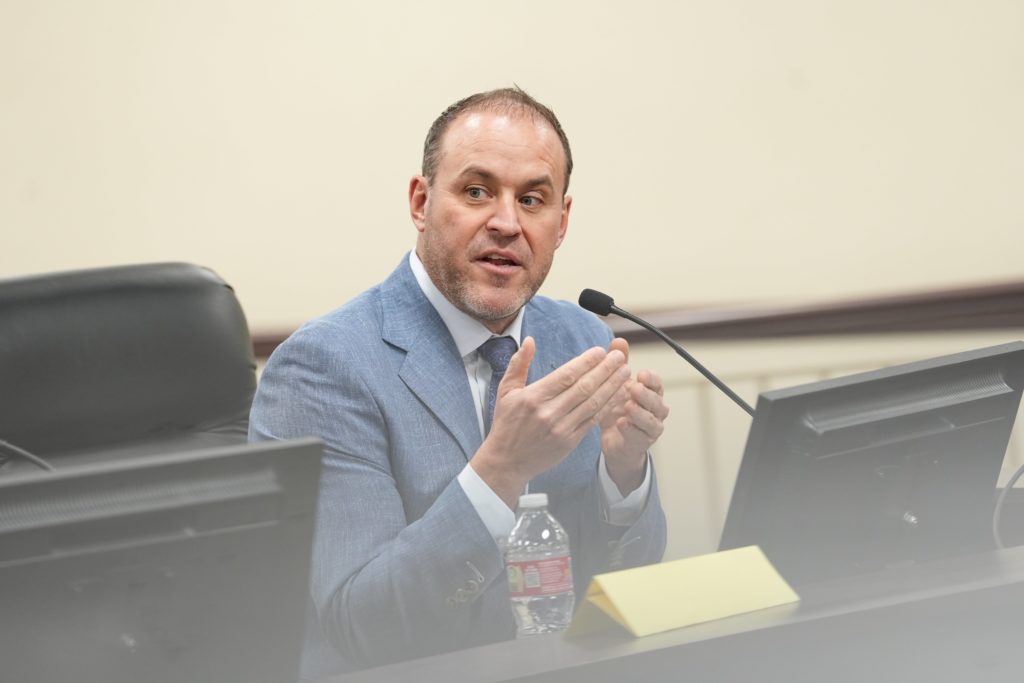
Speaker Mike Schultz is asking Gov. Spencer Cox to include a proposal in the fall special session of the Utah Legislature that would authorize Utah Forestry, Fire and State Lands to raise the Great Salt Lake causeway berm from 4,190 feet to 4,192 feet. The goal is to give state officials more flexibility to protect the lake’s critical South Arm ecosystem.
“We’ve taken a lot of great positive steps over the last several years to make sure that we don’t get to that level again,” Schultz said. “One of those was the berm management between the North Arm and the South Arm of the Great Salt Lake. That’s proven to be a really effective tool. Quite honestly, it’s probably what saved the Great Salt Lake a couple of years ago when we raised that berm.”
During a press conference with the Great Salt Lake Collaborative, Schultz sat alongside Jamie Barnes, director of Utah Forestry, Fire and State Lands, to explain the plan and its potential impact. Schultz will formally petition the governor to include the berm measure on the call for a fall special session, if it proves to be beneficial.
“We think that possibly could add some additional tools to the toolbox to help the ecosystem on the South Arm,” he said. “If it looks like it makes sense, we petitioned the governor to add it to the special session that we’re likely to have sometime this fall.”
Barnes said the state is evaluating the ecological tradeoffs of raising the berm, including the effects on water flow, salinity, and long-term management. Schultz acknowledged those uncertainties.
“It may help, may not,” Schultz said. “But let’s have the tools and the flexibility to do it if they think that it might help.”
The berm was last raised in 2022, a year when the lake reached historic lows and South Arm salinity spiked to 18.7 percent. That action is widely credited with avoiding ecosystem collapse. Schultz said the North and South Arms are now within six inches of each other.
“At some point in time that berm would get opened back up,” he said. “We’re here to save the whole Great Salt Lake.”
The proposed adjustment builds on previous legislation. Schultz highlighted House Bill 453, which created a water distribution management plan and set new conditions for mineral extraction companies operating on the lake.
“In HB 453, we also put in there that mineral companies have to stop taking water out after 4193 unless they entered into a voluntary agreement,” he said. “The ones that haven’t are getting cut off, and they’re not going to be able to take water out of the South Arm.”
Barnes praised the legislature’s role in building water protections into the law.
“The speaker’s done heroic efforts on Great Salt Lake,” Barnes said. “Those voluntary agreements that we’ve entered into with mineral companies, 255,000 acre feet donated by Compass Minerals in that voluntary agreement.”
Both Schultz and Barnes stressed that the state will continue using every available strategy to protect the lake. That includes invasive species removal, wetland restoration, and upstream forest management.
“I think it’s important for people to understand that we’re not taking our eyes off of this,” Schultz said. “We are still actively engaged in making sure that we manage the lake in a way to increase the levels and specifically protect the ecosystem that’s out there.”
When asked if the pause on new water legislation he called for last session might be lifted, Schultz said the state is ready to revisit policy ideas that are working.